Expropriation for Foreign Investors: Legal and Compensation Analysis
VerifiedAdded on 2023/01/23
|23
|8460
|25
Essay
AI Summary
This essay delves into the multifaceted issue of expropriation concerning foreign investors. It begins by establishing the fundamental right of a state to expropriate property while acknowledging the debates surrounding compensation. The paper traces the evolution of expropriation, highlighting the shift towards indirect expropriation driven by international investment agreements and governmental influences on economies. It explores the legal framework, including conditions for lawful expropriation and the impact of economic crises. The essay then examines different types of expropriation, including direct, indirect, and creeping expropriation, outlining their characteristics and legal implications. It further investigates the critical element of compensation, discussing valuation approaches and standards derived from customary international statutes and bilateral investment treaties. The analysis includes examining the Iran-United States Treaty of Amity, Economic, and Consular Rights to understand compensation standards. Overall, the essay provides a comprehensive overview of expropriation's legal, economic, and political dimensions, offering insights into the rights of investors and the actions of governments.
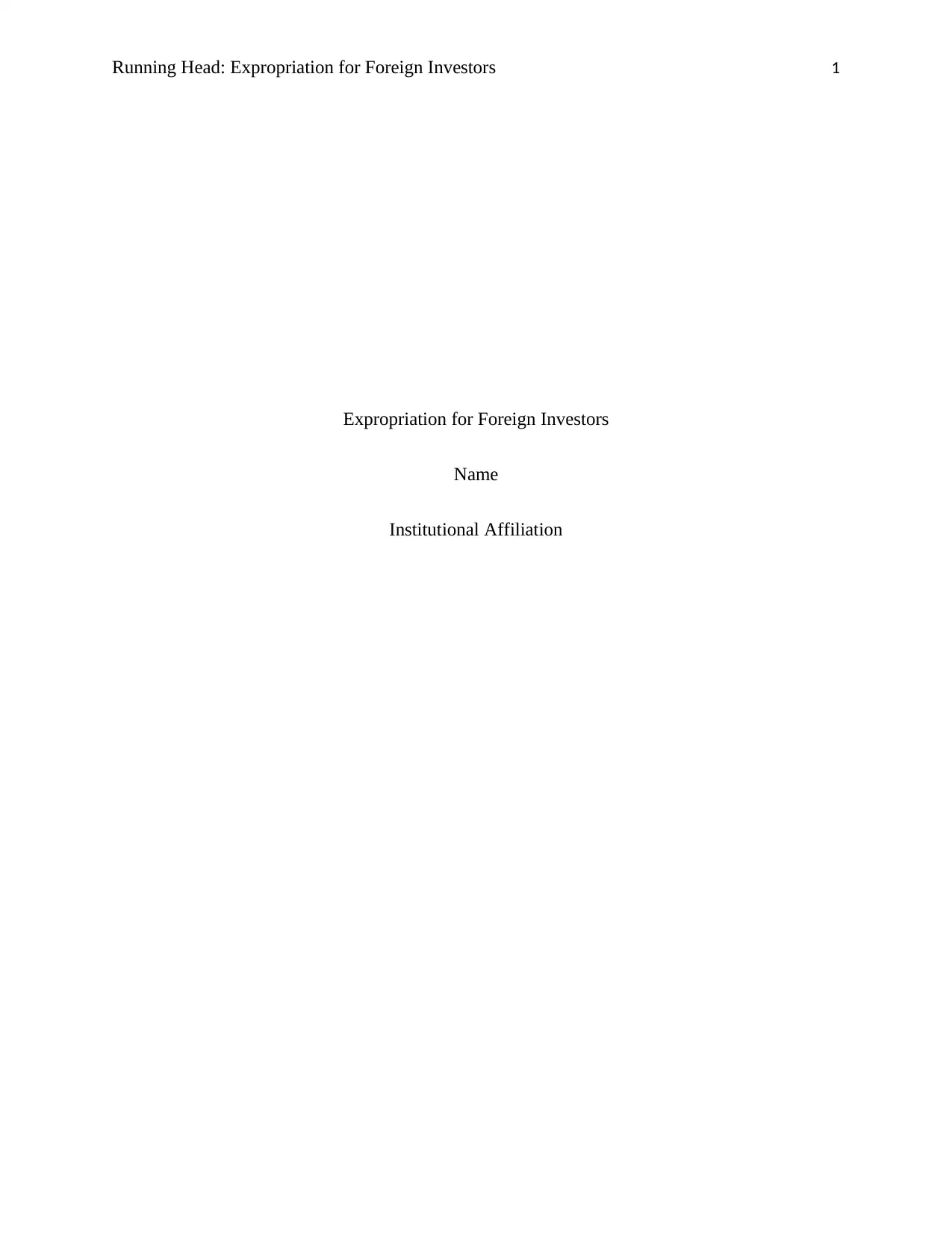
Running Head: Expropriation for Foreign Investors 1
Expropriation for Foreign Investors
Name
Institutional Affiliation
Expropriation for Foreign Investors
Name
Institutional Affiliation
Paraphrase This Document
Need a fresh take? Get an instant paraphrase of this document with our AI Paraphraser
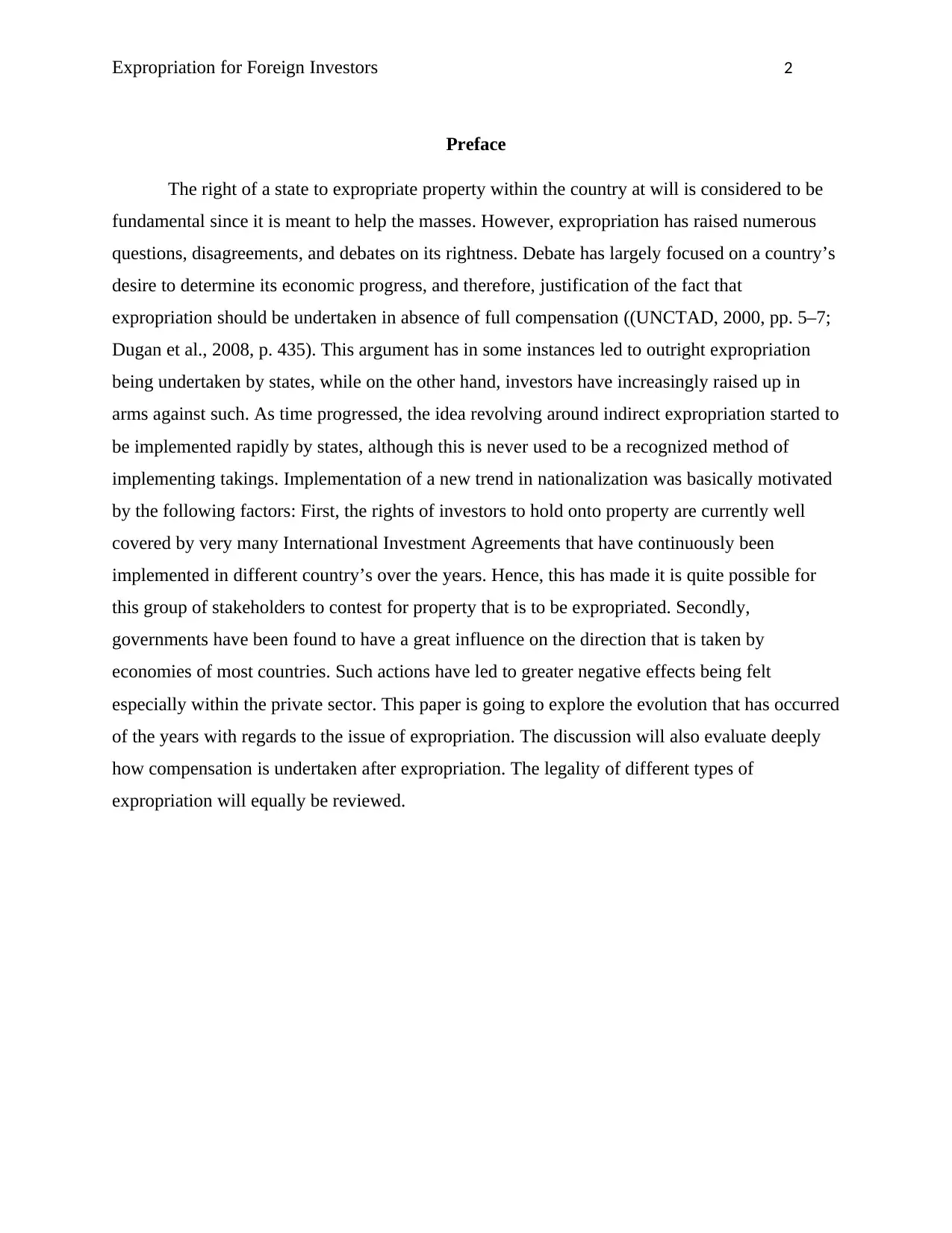
Expropriation for Foreign Investors 2
Preface
The right of a state to expropriate property within the country at will is considered to be
fundamental since it is meant to help the masses. However, expropriation has raised numerous
questions, disagreements, and debates on its rightness. Debate has largely focused on a country’s
desire to determine its economic progress, and therefore, justification of the fact that
expropriation should be undertaken in absence of full compensation ((UNCTAD, 2000, pp. 5–7;
Dugan et al., 2008, p. 435). This argument has in some instances led to outright expropriation
being undertaken by states, while on the other hand, investors have increasingly raised up in
arms against such. As time progressed, the idea revolving around indirect expropriation started to
be implemented rapidly by states, although this is never used to be a recognized method of
implementing takings. Implementation of a new trend in nationalization was basically motivated
by the following factors: First, the rights of investors to hold onto property are currently well
covered by very many International Investment Agreements that have continuously been
implemented in different country’s over the years. Hence, this has made it is quite possible for
this group of stakeholders to contest for property that is to be expropriated. Secondly,
governments have been found to have a great influence on the direction that is taken by
economies of most countries. Such actions have led to greater negative effects being felt
especially within the private sector. This paper is going to explore the evolution that has occurred
of the years with regards to the issue of expropriation. The discussion will also evaluate deeply
how compensation is undertaken after expropriation. The legality of different types of
expropriation will equally be reviewed.
Preface
The right of a state to expropriate property within the country at will is considered to be
fundamental since it is meant to help the masses. However, expropriation has raised numerous
questions, disagreements, and debates on its rightness. Debate has largely focused on a country’s
desire to determine its economic progress, and therefore, justification of the fact that
expropriation should be undertaken in absence of full compensation ((UNCTAD, 2000, pp. 5–7;
Dugan et al., 2008, p. 435). This argument has in some instances led to outright expropriation
being undertaken by states, while on the other hand, investors have increasingly raised up in
arms against such. As time progressed, the idea revolving around indirect expropriation started to
be implemented rapidly by states, although this is never used to be a recognized method of
implementing takings. Implementation of a new trend in nationalization was basically motivated
by the following factors: First, the rights of investors to hold onto property are currently well
covered by very many International Investment Agreements that have continuously been
implemented in different country’s over the years. Hence, this has made it is quite possible for
this group of stakeholders to contest for property that is to be expropriated. Secondly,
governments have been found to have a great influence on the direction that is taken by
economies of most countries. Such actions have led to greater negative effects being felt
especially within the private sector. This paper is going to explore the evolution that has occurred
of the years with regards to the issue of expropriation. The discussion will also evaluate deeply
how compensation is undertaken after expropriation. The legality of different types of
expropriation will equally be reviewed.
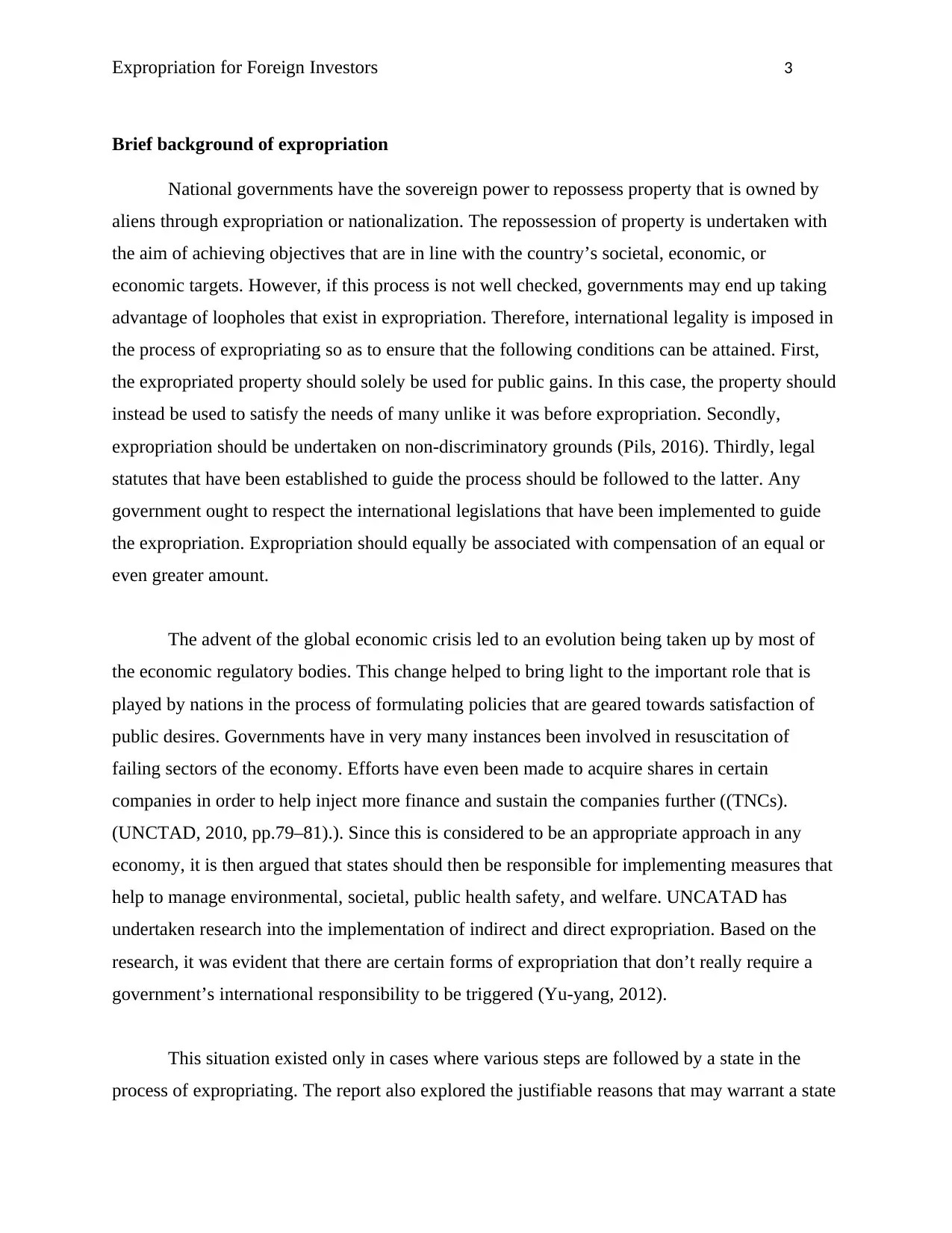
Expropriation for Foreign Investors 3
Brief background of expropriation
National governments have the sovereign power to repossess property that is owned by
aliens through expropriation or nationalization. The repossession of property is undertaken with
the aim of achieving objectives that are in line with the country’s societal, economic, or
economic targets. However, if this process is not well checked, governments may end up taking
advantage of loopholes that exist in expropriation. Therefore, international legality is imposed in
the process of expropriating so as to ensure that the following conditions can be attained. First,
the expropriated property should solely be used for public gains. In this case, the property should
instead be used to satisfy the needs of many unlike it was before expropriation. Secondly,
expropriation should be undertaken on non-discriminatory grounds (Pils, 2016). Thirdly, legal
statutes that have been established to guide the process should be followed to the latter. Any
government ought to respect the international legislations that have been implemented to guide
the expropriation. Expropriation should equally be associated with compensation of an equal or
even greater amount.
The advent of the global economic crisis led to an evolution being taken up by most of
the economic regulatory bodies. This change helped to bring light to the important role that is
played by nations in the process of formulating policies that are geared towards satisfaction of
public desires. Governments have in very many instances been involved in resuscitation of
failing sectors of the economy. Efforts have even been made to acquire shares in certain
companies in order to help inject more finance and sustain the companies further ((TNCs).
(UNCTAD, 2010, pp.79–81).). Since this is considered to be an appropriate approach in any
economy, it is then argued that states should then be responsible for implementing measures that
help to manage environmental, societal, public health safety, and welfare. UNCATAD has
undertaken research into the implementation of indirect and direct expropriation. Based on the
research, it was evident that there are certain forms of expropriation that don’t really require a
government’s international responsibility to be triggered (Yu-yang, 2012).
This situation existed only in cases where various steps are followed by a state in the
process of expropriating. The report also explored the justifiable reasons that may warrant a state
Brief background of expropriation
National governments have the sovereign power to repossess property that is owned by
aliens through expropriation or nationalization. The repossession of property is undertaken with
the aim of achieving objectives that are in line with the country’s societal, economic, or
economic targets. However, if this process is not well checked, governments may end up taking
advantage of loopholes that exist in expropriation. Therefore, international legality is imposed in
the process of expropriating so as to ensure that the following conditions can be attained. First,
the expropriated property should solely be used for public gains. In this case, the property should
instead be used to satisfy the needs of many unlike it was before expropriation. Secondly,
expropriation should be undertaken on non-discriminatory grounds (Pils, 2016). Thirdly, legal
statutes that have been established to guide the process should be followed to the latter. Any
government ought to respect the international legislations that have been implemented to guide
the expropriation. Expropriation should equally be associated with compensation of an equal or
even greater amount.
The advent of the global economic crisis led to an evolution being taken up by most of
the economic regulatory bodies. This change helped to bring light to the important role that is
played by nations in the process of formulating policies that are geared towards satisfaction of
public desires. Governments have in very many instances been involved in resuscitation of
failing sectors of the economy. Efforts have even been made to acquire shares in certain
companies in order to help inject more finance and sustain the companies further ((TNCs).
(UNCTAD, 2010, pp.79–81).). Since this is considered to be an appropriate approach in any
economy, it is then argued that states should then be responsible for implementing measures that
help to manage environmental, societal, public health safety, and welfare. UNCATAD has
undertaken research into the implementation of indirect and direct expropriation. Based on the
research, it was evident that there are certain forms of expropriation that don’t really require a
government’s international responsibility to be triggered (Yu-yang, 2012).
This situation existed only in cases where various steps are followed by a state in the
process of expropriating. The report also explored the justifiable reasons that may warrant a state
⊘ This is a preview!⊘
Do you want full access?
Subscribe today to unlock all pages.

Trusted by 1+ million students worldwide
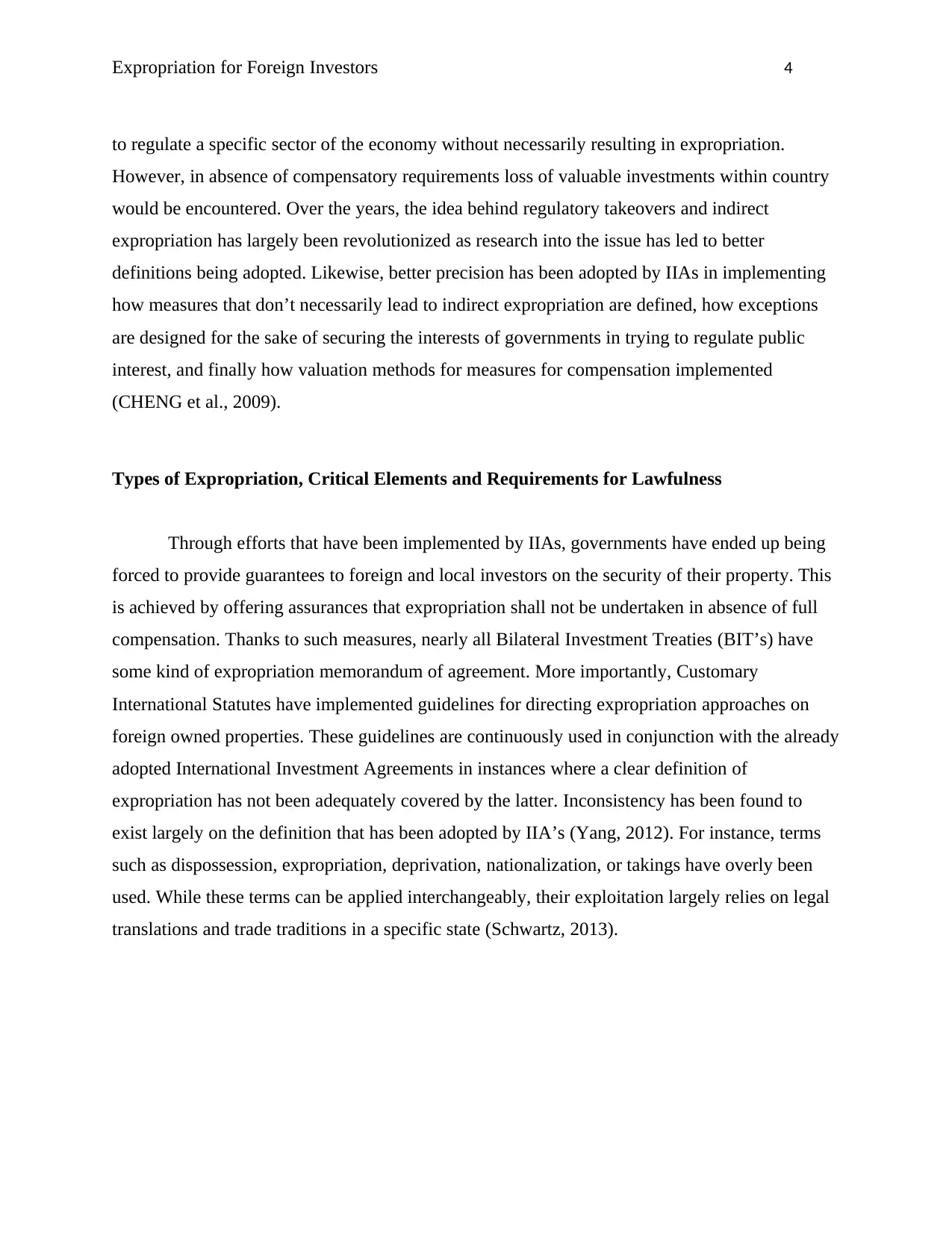
Expropriation for Foreign Investors 4
to regulate a specific sector of the economy without necessarily resulting in expropriation.
However, in absence of compensatory requirements loss of valuable investments within country
would be encountered. Over the years, the idea behind regulatory takeovers and indirect
expropriation has largely been revolutionized as research into the issue has led to better
definitions being adopted. Likewise, better precision has been adopted by IIAs in implementing
how measures that don’t necessarily lead to indirect expropriation are defined, how exceptions
are designed for the sake of securing the interests of governments in trying to regulate public
interest, and finally how valuation methods for measures for compensation implemented
(CHENG et al., 2009).
Types of Expropriation, Critical Elements and Requirements for Lawfulness
Through efforts that have been implemented by IIAs, governments have ended up being
forced to provide guarantees to foreign and local investors on the security of their property. This
is achieved by offering assurances that expropriation shall not be undertaken in absence of full
compensation. Thanks to such measures, nearly all Bilateral Investment Treaties (BIT’s) have
some kind of expropriation memorandum of agreement. More importantly, Customary
International Statutes have implemented guidelines for directing expropriation approaches on
foreign owned properties. These guidelines are continuously used in conjunction with the already
adopted International Investment Agreements in instances where a clear definition of
expropriation has not been adequately covered by the latter. Inconsistency has been found to
exist largely on the definition that has been adopted by IIA’s (Yang, 2012). For instance, terms
such as dispossession, expropriation, deprivation, nationalization, or takings have overly been
used. While these terms can be applied interchangeably, their exploitation largely relies on legal
translations and trade traditions in a specific state (Schwartz, 2013).
to regulate a specific sector of the economy without necessarily resulting in expropriation.
However, in absence of compensatory requirements loss of valuable investments within country
would be encountered. Over the years, the idea behind regulatory takeovers and indirect
expropriation has largely been revolutionized as research into the issue has led to better
definitions being adopted. Likewise, better precision has been adopted by IIAs in implementing
how measures that don’t necessarily lead to indirect expropriation are defined, how exceptions
are designed for the sake of securing the interests of governments in trying to regulate public
interest, and finally how valuation methods for measures for compensation implemented
(CHENG et al., 2009).
Types of Expropriation, Critical Elements and Requirements for Lawfulness
Through efforts that have been implemented by IIAs, governments have ended up being
forced to provide guarantees to foreign and local investors on the security of their property. This
is achieved by offering assurances that expropriation shall not be undertaken in absence of full
compensation. Thanks to such measures, nearly all Bilateral Investment Treaties (BIT’s) have
some kind of expropriation memorandum of agreement. More importantly, Customary
International Statutes have implemented guidelines for directing expropriation approaches on
foreign owned properties. These guidelines are continuously used in conjunction with the already
adopted International Investment Agreements in instances where a clear definition of
expropriation has not been adequately covered by the latter. Inconsistency has been found to
exist largely on the definition that has been adopted by IIA’s (Yang, 2012). For instance, terms
such as dispossession, expropriation, deprivation, nationalization, or takings have overly been
used. While these terms can be applied interchangeably, their exploitation largely relies on legal
translations and trade traditions in a specific state (Schwartz, 2013).
Paraphrase This Document
Need a fresh take? Get an instant paraphrase of this document with our AI Paraphraser
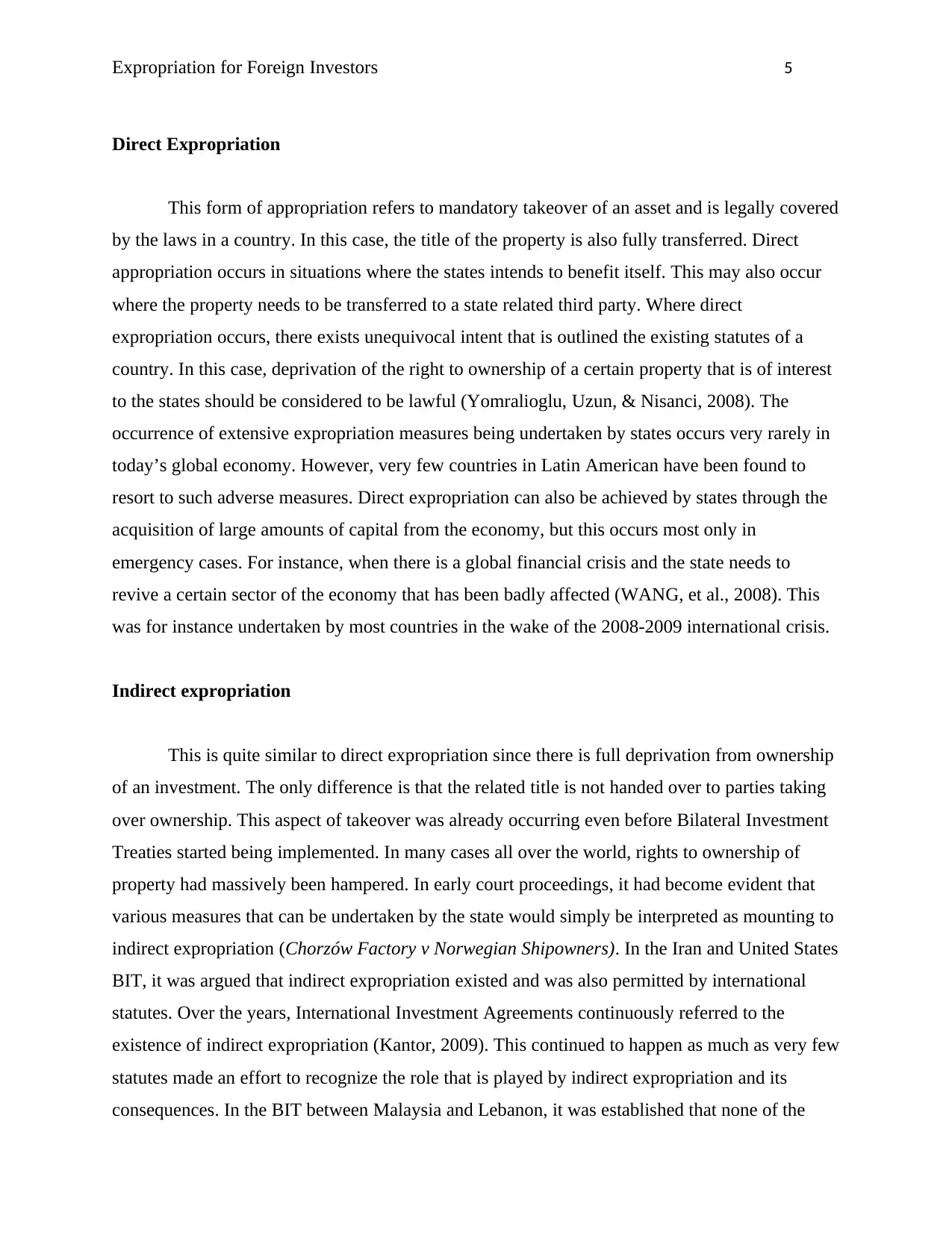
Expropriation for Foreign Investors 5
Direct Expropriation
This form of appropriation refers to mandatory takeover of an asset and is legally covered
by the laws in a country. In this case, the title of the property is also fully transferred. Direct
appropriation occurs in situations where the states intends to benefit itself. This may also occur
where the property needs to be transferred to a state related third party. Where direct
expropriation occurs, there exists unequivocal intent that is outlined the existing statutes of a
country. In this case, deprivation of the right to ownership of a certain property that is of interest
to the states should be considered to be lawful (Yomralioglu, Uzun, & Nisanci, 2008). The
occurrence of extensive expropriation measures being undertaken by states occurs very rarely in
today’s global economy. However, very few countries in Latin American have been found to
resort to such adverse measures. Direct expropriation can also be achieved by states through the
acquisition of large amounts of capital from the economy, but this occurs most only in
emergency cases. For instance, when there is a global financial crisis and the state needs to
revive a certain sector of the economy that has been badly affected (WANG, et al., 2008). This
was for instance undertaken by most countries in the wake of the 2008-2009 international crisis.
Indirect expropriation
This is quite similar to direct expropriation since there is full deprivation from ownership
of an investment. The only difference is that the related title is not handed over to parties taking
over ownership. This aspect of takeover was already occurring even before Bilateral Investment
Treaties started being implemented. In many cases all over the world, rights to ownership of
property had massively been hampered. In early court proceedings, it had become evident that
various measures that can be undertaken by the state would simply be interpreted as mounting to
indirect expropriation (Chorzów Factory v Norwegian Shipowners). In the Iran and United States
BIT, it was argued that indirect expropriation existed and was also permitted by international
statutes. Over the years, International Investment Agreements continuously referred to the
existence of indirect expropriation (Kantor, 2009). This continued to happen as much as very few
statutes made an effort to recognize the role that is played by indirect expropriation and its
consequences. In the BIT between Malaysia and Lebanon, it was established that none of the
Direct Expropriation
This form of appropriation refers to mandatory takeover of an asset and is legally covered
by the laws in a country. In this case, the title of the property is also fully transferred. Direct
appropriation occurs in situations where the states intends to benefit itself. This may also occur
where the property needs to be transferred to a state related third party. Where direct
expropriation occurs, there exists unequivocal intent that is outlined the existing statutes of a
country. In this case, deprivation of the right to ownership of a certain property that is of interest
to the states should be considered to be lawful (Yomralioglu, Uzun, & Nisanci, 2008). The
occurrence of extensive expropriation measures being undertaken by states occurs very rarely in
today’s global economy. However, very few countries in Latin American have been found to
resort to such adverse measures. Direct expropriation can also be achieved by states through the
acquisition of large amounts of capital from the economy, but this occurs most only in
emergency cases. For instance, when there is a global financial crisis and the state needs to
revive a certain sector of the economy that has been badly affected (WANG, et al., 2008). This
was for instance undertaken by most countries in the wake of the 2008-2009 international crisis.
Indirect expropriation
This is quite similar to direct expropriation since there is full deprivation from ownership
of an investment. The only difference is that the related title is not handed over to parties taking
over ownership. This aspect of takeover was already occurring even before Bilateral Investment
Treaties started being implemented. In many cases all over the world, rights to ownership of
property had massively been hampered. In early court proceedings, it had become evident that
various measures that can be undertaken by the state would simply be interpreted as mounting to
indirect expropriation (Chorzów Factory v Norwegian Shipowners). In the Iran and United States
BIT, it was argued that indirect expropriation existed and was also permitted by international
statutes. Over the years, International Investment Agreements continuously referred to the
existence of indirect expropriation (Kantor, 2009). This continued to happen as much as very few
statutes made an effort to recognize the role that is played by indirect expropriation and its
consequences. In the BIT between Malaysia and Lebanon, it was established that none of the
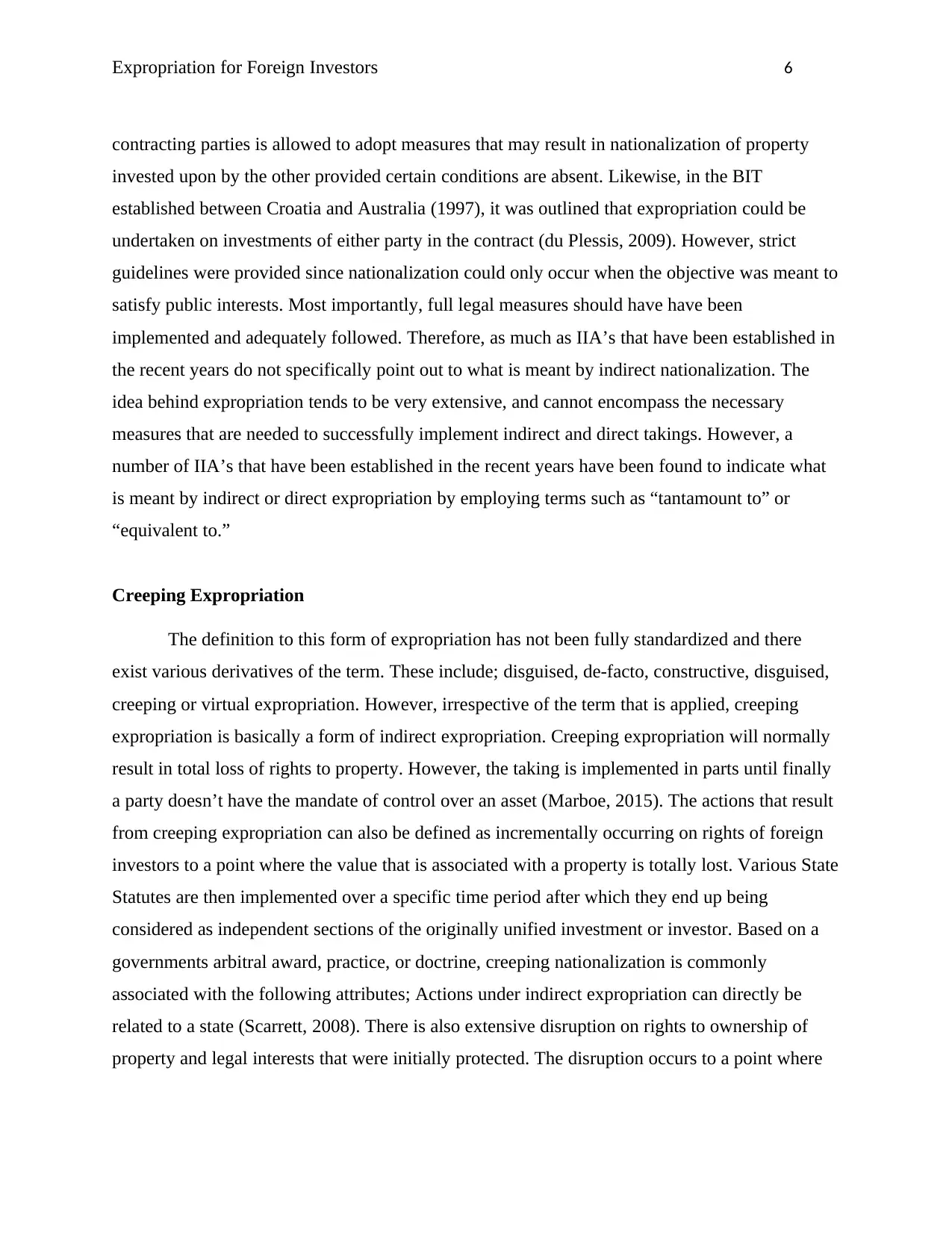
Expropriation for Foreign Investors 6
contracting parties is allowed to adopt measures that may result in nationalization of property
invested upon by the other provided certain conditions are absent. Likewise, in the BIT
established between Croatia and Australia (1997), it was outlined that expropriation could be
undertaken on investments of either party in the contract (du Plessis, 2009). However, strict
guidelines were provided since nationalization could only occur when the objective was meant to
satisfy public interests. Most importantly, full legal measures should have have been
implemented and adequately followed. Therefore, as much as IIA’s that have been established in
the recent years do not specifically point out to what is meant by indirect nationalization. The
idea behind expropriation tends to be very extensive, and cannot encompass the necessary
measures that are needed to successfully implement indirect and direct takings. However, a
number of IIA’s that have been established in the recent years have been found to indicate what
is meant by indirect or direct expropriation by employing terms such as “tantamount to” or
“equivalent to.”
Creeping Expropriation
The definition to this form of expropriation has not been fully standardized and there
exist various derivatives of the term. These include; disguised, de-facto, constructive, disguised,
creeping or virtual expropriation. However, irrespective of the term that is applied, creeping
expropriation is basically a form of indirect expropriation. Creeping expropriation will normally
result in total loss of rights to property. However, the taking is implemented in parts until finally
a party doesn’t have the mandate of control over an asset (Marboe, 2015). The actions that result
from creeping expropriation can also be defined as incrementally occurring on rights of foreign
investors to a point where the value that is associated with a property is totally lost. Various State
Statutes are then implemented over a specific time period after which they end up being
considered as independent sections of the originally unified investment or investor. Based on a
governments arbitral award, practice, or doctrine, creeping nationalization is commonly
associated with the following attributes; Actions under indirect expropriation can directly be
related to a state (Scarrett, 2008). There is also extensive disruption on rights to ownership of
property and legal interests that were initially protected. The disruption occurs to a point where
contracting parties is allowed to adopt measures that may result in nationalization of property
invested upon by the other provided certain conditions are absent. Likewise, in the BIT
established between Croatia and Australia (1997), it was outlined that expropriation could be
undertaken on investments of either party in the contract (du Plessis, 2009). However, strict
guidelines were provided since nationalization could only occur when the objective was meant to
satisfy public interests. Most importantly, full legal measures should have have been
implemented and adequately followed. Therefore, as much as IIA’s that have been established in
the recent years do not specifically point out to what is meant by indirect nationalization. The
idea behind expropriation tends to be very extensive, and cannot encompass the necessary
measures that are needed to successfully implement indirect and direct takings. However, a
number of IIA’s that have been established in the recent years have been found to indicate what
is meant by indirect or direct expropriation by employing terms such as “tantamount to” or
“equivalent to.”
Creeping Expropriation
The definition to this form of expropriation has not been fully standardized and there
exist various derivatives of the term. These include; disguised, de-facto, constructive, disguised,
creeping or virtual expropriation. However, irrespective of the term that is applied, creeping
expropriation is basically a form of indirect expropriation. Creeping expropriation will normally
result in total loss of rights to property. However, the taking is implemented in parts until finally
a party doesn’t have the mandate of control over an asset (Marboe, 2015). The actions that result
from creeping expropriation can also be defined as incrementally occurring on rights of foreign
investors to a point where the value that is associated with a property is totally lost. Various State
Statutes are then implemented over a specific time period after which they end up being
considered as independent sections of the originally unified investment or investor. Based on a
governments arbitral award, practice, or doctrine, creeping nationalization is commonly
associated with the following attributes; Actions under indirect expropriation can directly be
related to a state (Scarrett, 2008). There is also extensive disruption on rights to ownership of
property and legal interests that were initially protected. The disruption occurs to a point where
⊘ This is a preview!⊘
Do you want full access?
Subscribe today to unlock all pages.

Trusted by 1+ million students worldwide
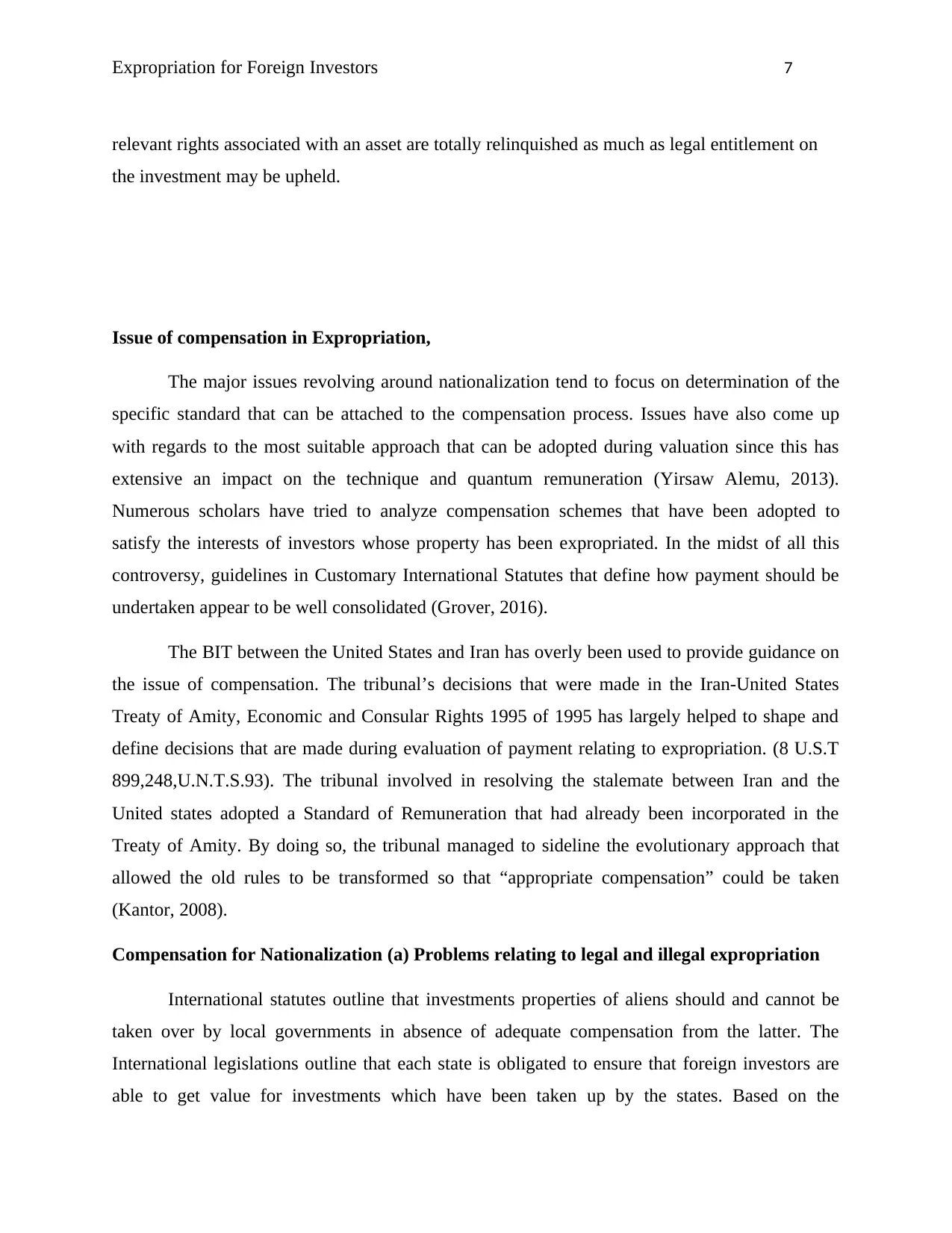
Expropriation for Foreign Investors 7
relevant rights associated with an asset are totally relinquished as much as legal entitlement on
the investment may be upheld.
Issue of compensation in Expropriation,
The major issues revolving around nationalization tend to focus on determination of the
specific standard that can be attached to the compensation process. Issues have also come up
with regards to the most suitable approach that can be adopted during valuation since this has
extensive an impact on the technique and quantum remuneration (Yirsaw Alemu, 2013).
Numerous scholars have tried to analyze compensation schemes that have been adopted to
satisfy the interests of investors whose property has been expropriated. In the midst of all this
controversy, guidelines in Customary International Statutes that define how payment should be
undertaken appear to be well consolidated (Grover, 2016).
The BIT between the United States and Iran has overly been used to provide guidance on
the issue of compensation. The tribunal’s decisions that were made in the Iran-United States
Treaty of Amity, Economic and Consular Rights 1995 of 1995 has largely helped to shape and
define decisions that are made during evaluation of payment relating to expropriation. (8 U.S.T
899,248,U.N.T.S.93). The tribunal involved in resolving the stalemate between Iran and the
United states adopted a Standard of Remuneration that had already been incorporated in the
Treaty of Amity. By doing so, the tribunal managed to sideline the evolutionary approach that
allowed the old rules to be transformed so that “appropriate compensation” could be taken
(Kantor, 2008).
Compensation for Nationalization (a) Problems relating to legal and illegal expropriation
International statutes outline that investments properties of aliens should and cannot be
taken over by local governments in absence of adequate compensation from the latter. The
International legislations outline that each state is obligated to ensure that foreign investors are
able to get value for investments which have been taken up by the states. Based on the
relevant rights associated with an asset are totally relinquished as much as legal entitlement on
the investment may be upheld.
Issue of compensation in Expropriation,
The major issues revolving around nationalization tend to focus on determination of the
specific standard that can be attached to the compensation process. Issues have also come up
with regards to the most suitable approach that can be adopted during valuation since this has
extensive an impact on the technique and quantum remuneration (Yirsaw Alemu, 2013).
Numerous scholars have tried to analyze compensation schemes that have been adopted to
satisfy the interests of investors whose property has been expropriated. In the midst of all this
controversy, guidelines in Customary International Statutes that define how payment should be
undertaken appear to be well consolidated (Grover, 2016).
The BIT between the United States and Iran has overly been used to provide guidance on
the issue of compensation. The tribunal’s decisions that were made in the Iran-United States
Treaty of Amity, Economic and Consular Rights 1995 of 1995 has largely helped to shape and
define decisions that are made during evaluation of payment relating to expropriation. (8 U.S.T
899,248,U.N.T.S.93). The tribunal involved in resolving the stalemate between Iran and the
United states adopted a Standard of Remuneration that had already been incorporated in the
Treaty of Amity. By doing so, the tribunal managed to sideline the evolutionary approach that
allowed the old rules to be transformed so that “appropriate compensation” could be taken
(Kantor, 2008).
Compensation for Nationalization (a) Problems relating to legal and illegal expropriation
International statutes outline that investments properties of aliens should and cannot be
taken over by local governments in absence of adequate compensation from the latter. The
International legislations outline that each state is obligated to ensure that foreign investors are
able to get value for investments which have been taken up by the states. Based on the
Paraphrase This Document
Need a fresh take? Get an instant paraphrase of this document with our AI Paraphraser
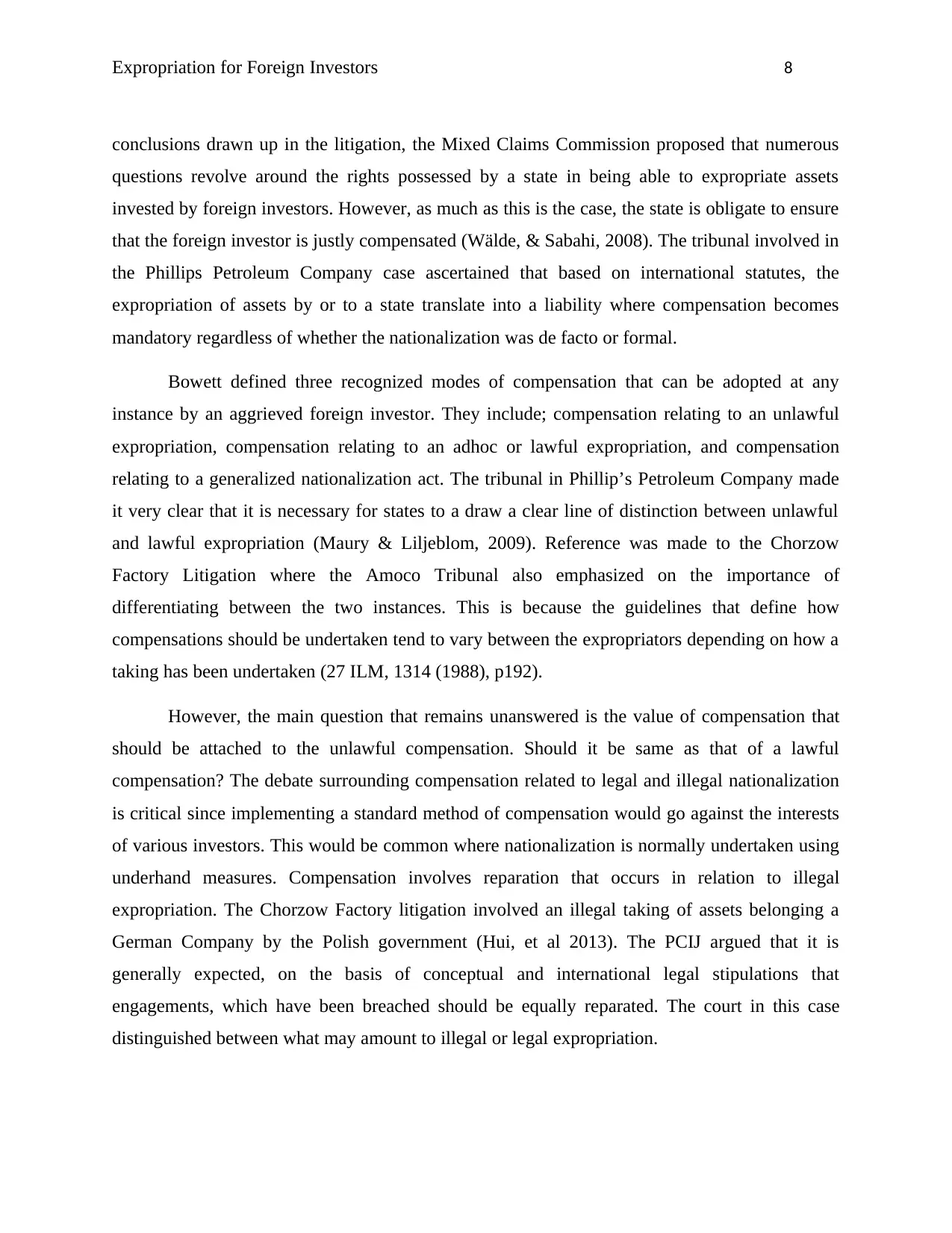
Expropriation for Foreign Investors 8
conclusions drawn up in the litigation, the Mixed Claims Commission proposed that numerous
questions revolve around the rights possessed by a state in being able to expropriate assets
invested by foreign investors. However, as much as this is the case, the state is obligate to ensure
that the foreign investor is justly compensated (Wälde, & Sabahi, 2008). The tribunal involved in
the Phillips Petroleum Company case ascertained that based on international statutes, the
expropriation of assets by or to a state translate into a liability where compensation becomes
mandatory regardless of whether the nationalization was de facto or formal.
Bowett defined three recognized modes of compensation that can be adopted at any
instance by an aggrieved foreign investor. They include; compensation relating to an unlawful
expropriation, compensation relating to an adhoc or lawful expropriation, and compensation
relating to a generalized nationalization act. The tribunal in Phillip’s Petroleum Company made
it very clear that it is necessary for states to a draw a clear line of distinction between unlawful
and lawful expropriation (Maury & Liljeblom, 2009). Reference was made to the Chorzow
Factory Litigation where the Amoco Tribunal also emphasized on the importance of
differentiating between the two instances. This is because the guidelines that define how
compensations should be undertaken tend to vary between the expropriators depending on how a
taking has been undertaken (27 ILM, 1314 (1988), p192).
However, the main question that remains unanswered is the value of compensation that
should be attached to the unlawful compensation. Should it be same as that of a lawful
compensation? The debate surrounding compensation related to legal and illegal nationalization
is critical since implementing a standard method of compensation would go against the interests
of various investors. This would be common where nationalization is normally undertaken using
underhand measures. Compensation involves reparation that occurs in relation to illegal
expropriation. The Chorzow Factory litigation involved an illegal taking of assets belonging a
German Company by the Polish government (Hui, et al 2013). The PCIJ argued that it is
generally expected, on the basis of conceptual and international legal stipulations that
engagements, which have been breached should be equally reparated. The court in this case
distinguished between what may amount to illegal or legal expropriation.
conclusions drawn up in the litigation, the Mixed Claims Commission proposed that numerous
questions revolve around the rights possessed by a state in being able to expropriate assets
invested by foreign investors. However, as much as this is the case, the state is obligate to ensure
that the foreign investor is justly compensated (Wälde, & Sabahi, 2008). The tribunal involved in
the Phillips Petroleum Company case ascertained that based on international statutes, the
expropriation of assets by or to a state translate into a liability where compensation becomes
mandatory regardless of whether the nationalization was de facto or formal.
Bowett defined three recognized modes of compensation that can be adopted at any
instance by an aggrieved foreign investor. They include; compensation relating to an unlawful
expropriation, compensation relating to an adhoc or lawful expropriation, and compensation
relating to a generalized nationalization act. The tribunal in Phillip’s Petroleum Company made
it very clear that it is necessary for states to a draw a clear line of distinction between unlawful
and lawful expropriation (Maury & Liljeblom, 2009). Reference was made to the Chorzow
Factory Litigation where the Amoco Tribunal also emphasized on the importance of
differentiating between the two instances. This is because the guidelines that define how
compensations should be undertaken tend to vary between the expropriators depending on how a
taking has been undertaken (27 ILM, 1314 (1988), p192).
However, the main question that remains unanswered is the value of compensation that
should be attached to the unlawful compensation. Should it be same as that of a lawful
compensation? The debate surrounding compensation related to legal and illegal nationalization
is critical since implementing a standard method of compensation would go against the interests
of various investors. This would be common where nationalization is normally undertaken using
underhand measures. Compensation involves reparation that occurs in relation to illegal
expropriation. The Chorzow Factory litigation involved an illegal taking of assets belonging a
German Company by the Polish government (Hui, et al 2013). The PCIJ argued that it is
generally expected, on the basis of conceptual and international legal stipulations that
engagements, which have been breached should be equally reparated. The court in this case
distinguished between what may amount to illegal or legal expropriation.

Expropriation for Foreign Investors 9
The court also ascertained that the primary principle, which is apparently adopted by all
international statutes, and most importantly by the decisions of other tribunals, is based on the
fact that reparation is outrightly necessary. The act should as much as possible eliminate
consequences resulting from unlawful nationalization, by making efforts to revert the investors
situation back to normalcy. Normalcy, in this case, is defined as the situation that would have
existed were it not for the unlawful expropriation by the state. When expropriation is undertaken
by a state in a lawful manner, restitution will not be enforced in most of the cases. However, it is
up to the nationalizing state to ensure that it pays pecuniary remuneration that amounts to actual
value of asset that was nationalized (Bernasconi-Osterwalder, Cosbey, & Johnson, 2000).
In a huge number of expropriation cases, the primary issue that faced the tribunal
revolved around whether the application of general standards made a reference to conclusions
that were drawn in the International Customary Statutes, or to the 1955 United States-Iran Treaty
of Amity, Economic Relations and Consular Rights. The treaty proposes in Article 4 s2 that:
investments that are owned by companies or nationals from high contracting parties, while
incorporating interest held in the investments, should be associated with the highest degree of
security and protection (Porterfield, 2011). This should be done when investments have equally
been set up in territories of high contracting parties. Most importantly, this should be undertaken
on BIT’s that have adequately incorporated international statutes. Expropriation of such
properties should only be undertaken only in instances where the taking is for the benefit of the
public majority, and should be associated with an equally matching compensation amount.
Compensation relating to such will be done in a manner that is adequately realizable, and should
in effect reflect on the full value of the property that has been acquired. Finally, a sufficient
determination should have been undertaken before or during the time of expropriation for the
purpose of understanding the full value of the payment (Konowalczuk & Ramian 2010).
In the litigation between Iran v American International Group (,( 84 ILR 645 (1991),654-
656)) it was concluded by the tribunal that based on the International Customary Statutes, it was
necessary that the full compensation be undertaken. Additionally, there was no need of referring
to the Treaty of Amity on how conclusion from the litigation could be applied to this particular
case. Iran Government argued that the Treaty of Amity was obsolete, and even in the case that it
could be applicable, expropriating the insurance industry in Iran would translate into actual
The court also ascertained that the primary principle, which is apparently adopted by all
international statutes, and most importantly by the decisions of other tribunals, is based on the
fact that reparation is outrightly necessary. The act should as much as possible eliminate
consequences resulting from unlawful nationalization, by making efforts to revert the investors
situation back to normalcy. Normalcy, in this case, is defined as the situation that would have
existed were it not for the unlawful expropriation by the state. When expropriation is undertaken
by a state in a lawful manner, restitution will not be enforced in most of the cases. However, it is
up to the nationalizing state to ensure that it pays pecuniary remuneration that amounts to actual
value of asset that was nationalized (Bernasconi-Osterwalder, Cosbey, & Johnson, 2000).
In a huge number of expropriation cases, the primary issue that faced the tribunal
revolved around whether the application of general standards made a reference to conclusions
that were drawn in the International Customary Statutes, or to the 1955 United States-Iran Treaty
of Amity, Economic Relations and Consular Rights. The treaty proposes in Article 4 s2 that:
investments that are owned by companies or nationals from high contracting parties, while
incorporating interest held in the investments, should be associated with the highest degree of
security and protection (Porterfield, 2011). This should be done when investments have equally
been set up in territories of high contracting parties. Most importantly, this should be undertaken
on BIT’s that have adequately incorporated international statutes. Expropriation of such
properties should only be undertaken only in instances where the taking is for the benefit of the
public majority, and should be associated with an equally matching compensation amount.
Compensation relating to such will be done in a manner that is adequately realizable, and should
in effect reflect on the full value of the property that has been acquired. Finally, a sufficient
determination should have been undertaken before or during the time of expropriation for the
purpose of understanding the full value of the payment (Konowalczuk & Ramian 2010).
In the litigation between Iran v American International Group (,( 84 ILR 645 (1991),654-
656)) it was concluded by the tribunal that based on the International Customary Statutes, it was
necessary that the full compensation be undertaken. Additionally, there was no need of referring
to the Treaty of Amity on how conclusion from the litigation could be applied to this particular
case. Iran Government argued that the Treaty of Amity was obsolete, and even in the case that it
could be applicable, expropriating the insurance industry in Iran would translate into actual
⊘ This is a preview!⊘
Do you want full access?
Subscribe today to unlock all pages.

Trusted by 1+ million students worldwide
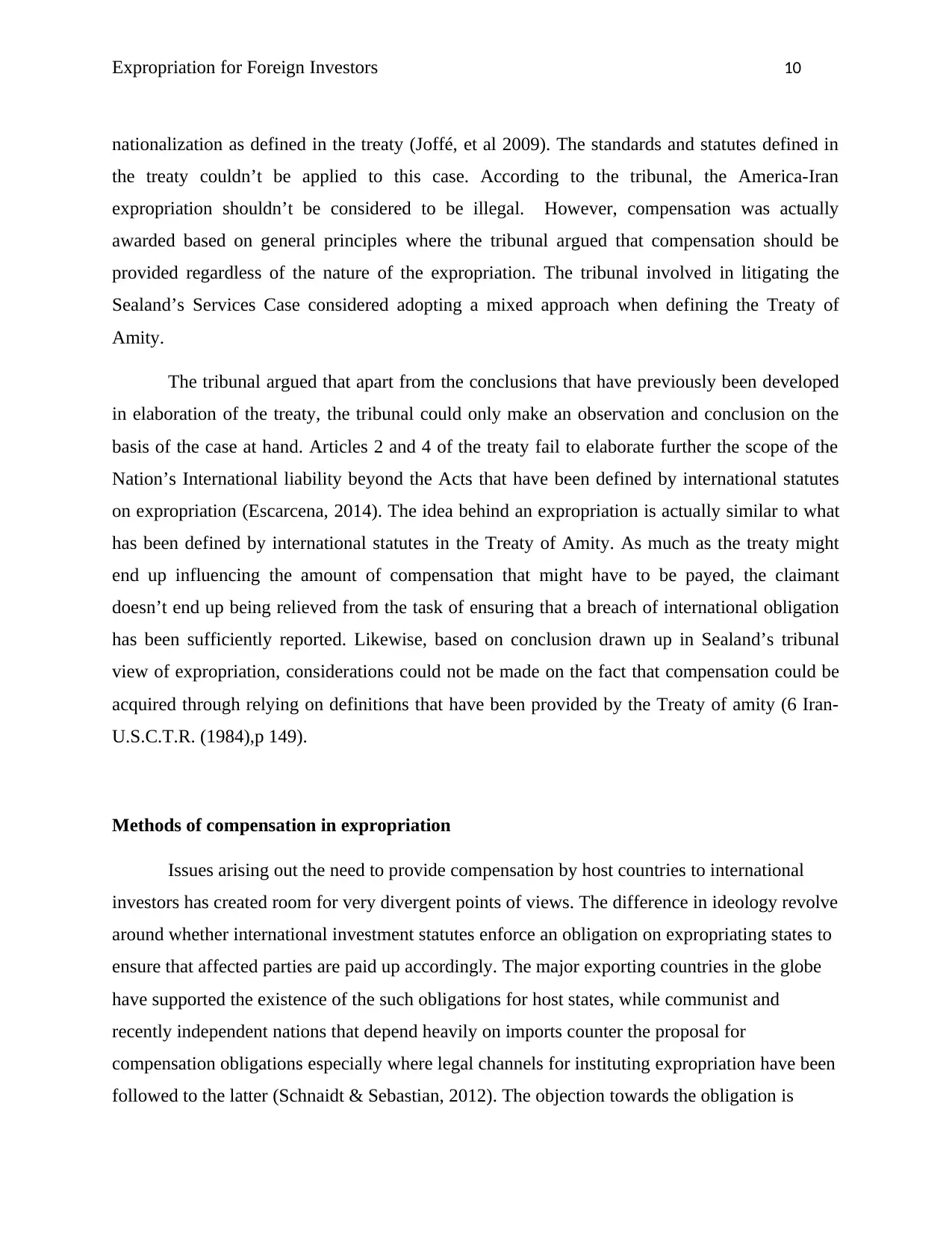
Expropriation for Foreign Investors 10
nationalization as defined in the treaty (Joffé, et al 2009). The standards and statutes defined in
the treaty couldn’t be applied to this case. According to the tribunal, the America-Iran
expropriation shouldn’t be considered to be illegal. However, compensation was actually
awarded based on general principles where the tribunal argued that compensation should be
provided regardless of the nature of the expropriation. The tribunal involved in litigating the
Sealand’s Services Case considered adopting a mixed approach when defining the Treaty of
Amity.
The tribunal argued that apart from the conclusions that have previously been developed
in elaboration of the treaty, the tribunal could only make an observation and conclusion on the
basis of the case at hand. Articles 2 and 4 of the treaty fail to elaborate further the scope of the
Nation’s International liability beyond the Acts that have been defined by international statutes
on expropriation (Escarcena, 2014). The idea behind an expropriation is actually similar to what
has been defined by international statutes in the Treaty of Amity. As much as the treaty might
end up influencing the amount of compensation that might have to be payed, the claimant
doesn’t end up being relieved from the task of ensuring that a breach of international obligation
has been sufficiently reported. Likewise, based on conclusion drawn up in Sealand’s tribunal
view of expropriation, considerations could not be made on the fact that compensation could be
acquired through relying on definitions that have been provided by the Treaty of amity (6 Iran-
U.S.C.T.R. (1984),p 149).
Methods of compensation in expropriation
Issues arising out the need to provide compensation by host countries to international
investors has created room for very divergent points of views. The difference in ideology revolve
around whether international investment statutes enforce an obligation on expropriating states to
ensure that affected parties are paid up accordingly. The major exporting countries in the globe
have supported the existence of the such obligations for host states, while communist and
recently independent nations that depend heavily on imports counter the proposal for
compensation obligations especially where legal channels for instituting expropriation have been
followed to the latter (Schnaidt & Sebastian, 2012). The objection towards the obligation is
nationalization as defined in the treaty (Joffé, et al 2009). The standards and statutes defined in
the treaty couldn’t be applied to this case. According to the tribunal, the America-Iran
expropriation shouldn’t be considered to be illegal. However, compensation was actually
awarded based on general principles where the tribunal argued that compensation should be
provided regardless of the nature of the expropriation. The tribunal involved in litigating the
Sealand’s Services Case considered adopting a mixed approach when defining the Treaty of
Amity.
The tribunal argued that apart from the conclusions that have previously been developed
in elaboration of the treaty, the tribunal could only make an observation and conclusion on the
basis of the case at hand. Articles 2 and 4 of the treaty fail to elaborate further the scope of the
Nation’s International liability beyond the Acts that have been defined by international statutes
on expropriation (Escarcena, 2014). The idea behind an expropriation is actually similar to what
has been defined by international statutes in the Treaty of Amity. As much as the treaty might
end up influencing the amount of compensation that might have to be payed, the claimant
doesn’t end up being relieved from the task of ensuring that a breach of international obligation
has been sufficiently reported. Likewise, based on conclusion drawn up in Sealand’s tribunal
view of expropriation, considerations could not be made on the fact that compensation could be
acquired through relying on definitions that have been provided by the Treaty of amity (6 Iran-
U.S.C.T.R. (1984),p 149).
Methods of compensation in expropriation
Issues arising out the need to provide compensation by host countries to international
investors has created room for very divergent points of views. The difference in ideology revolve
around whether international investment statutes enforce an obligation on expropriating states to
ensure that affected parties are paid up accordingly. The major exporting countries in the globe
have supported the existence of the such obligations for host states, while communist and
recently independent nations that depend heavily on imports counter the proposal for
compensation obligations especially where legal channels for instituting expropriation have been
followed to the latter (Schnaidt & Sebastian, 2012). The objection towards the obligation is
Paraphrase This Document
Need a fresh take? Get an instant paraphrase of this document with our AI Paraphraser
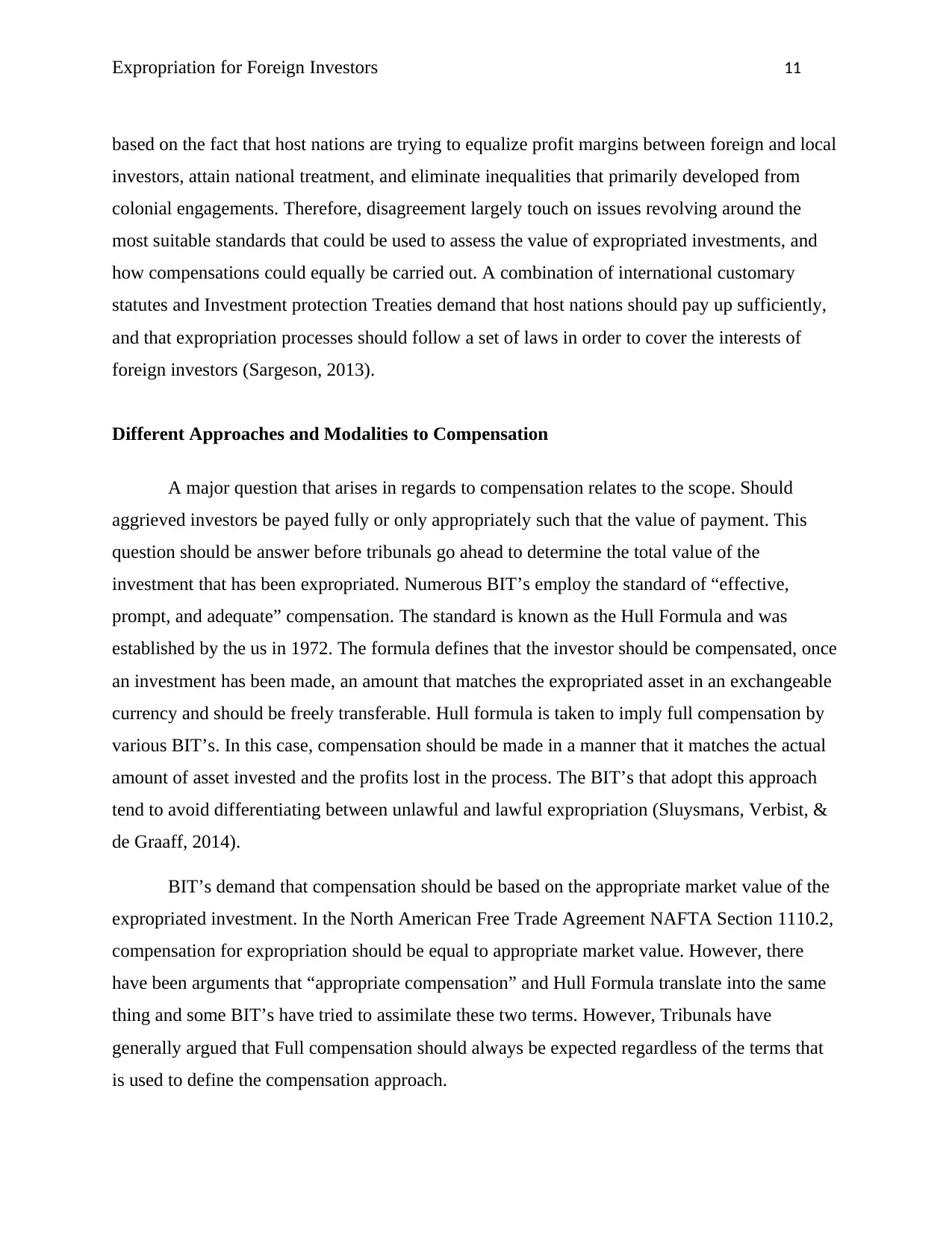
Expropriation for Foreign Investors 11
based on the fact that host nations are trying to equalize profit margins between foreign and local
investors, attain national treatment, and eliminate inequalities that primarily developed from
colonial engagements. Therefore, disagreement largely touch on issues revolving around the
most suitable standards that could be used to assess the value of expropriated investments, and
how compensations could equally be carried out. A combination of international customary
statutes and Investment protection Treaties demand that host nations should pay up sufficiently,
and that expropriation processes should follow a set of laws in order to cover the interests of
foreign investors (Sargeson, 2013).
Different Approaches and Modalities to Compensation
A major question that arises in regards to compensation relates to the scope. Should
aggrieved investors be payed fully or only appropriately such that the value of payment. This
question should be answer before tribunals go ahead to determine the total value of the
investment that has been expropriated. Numerous BIT’s employ the standard of “effective,
prompt, and adequate” compensation. The standard is known as the Hull Formula and was
established by the us in 1972. The formula defines that the investor should be compensated, once
an investment has been made, an amount that matches the expropriated asset in an exchangeable
currency and should be freely transferable. Hull formula is taken to imply full compensation by
various BIT’s. In this case, compensation should be made in a manner that it matches the actual
amount of asset invested and the profits lost in the process. The BIT’s that adopt this approach
tend to avoid differentiating between unlawful and lawful expropriation (Sluysmans, Verbist, &
de Graaff, 2014).
BIT’s demand that compensation should be based on the appropriate market value of the
expropriated investment. In the North American Free Trade Agreement NAFTA Section 1110.2,
compensation for expropriation should be equal to appropriate market value. However, there
have been arguments that “appropriate compensation” and Hull Formula translate into the same
thing and some BIT’s have tried to assimilate these two terms. However, Tribunals have
generally argued that Full compensation should always be expected regardless of the terms that
is used to define the compensation approach.
based on the fact that host nations are trying to equalize profit margins between foreign and local
investors, attain national treatment, and eliminate inequalities that primarily developed from
colonial engagements. Therefore, disagreement largely touch on issues revolving around the
most suitable standards that could be used to assess the value of expropriated investments, and
how compensations could equally be carried out. A combination of international customary
statutes and Investment protection Treaties demand that host nations should pay up sufficiently,
and that expropriation processes should follow a set of laws in order to cover the interests of
foreign investors (Sargeson, 2013).
Different Approaches and Modalities to Compensation
A major question that arises in regards to compensation relates to the scope. Should
aggrieved investors be payed fully or only appropriately such that the value of payment. This
question should be answer before tribunals go ahead to determine the total value of the
investment that has been expropriated. Numerous BIT’s employ the standard of “effective,
prompt, and adequate” compensation. The standard is known as the Hull Formula and was
established by the us in 1972. The formula defines that the investor should be compensated, once
an investment has been made, an amount that matches the expropriated asset in an exchangeable
currency and should be freely transferable. Hull formula is taken to imply full compensation by
various BIT’s. In this case, compensation should be made in a manner that it matches the actual
amount of asset invested and the profits lost in the process. The BIT’s that adopt this approach
tend to avoid differentiating between unlawful and lawful expropriation (Sluysmans, Verbist, &
de Graaff, 2014).
BIT’s demand that compensation should be based on the appropriate market value of the
expropriated investment. In the North American Free Trade Agreement NAFTA Section 1110.2,
compensation for expropriation should be equal to appropriate market value. However, there
have been arguments that “appropriate compensation” and Hull Formula translate into the same
thing and some BIT’s have tried to assimilate these two terms. However, Tribunals have
generally argued that Full compensation should always be expected regardless of the terms that
is used to define the compensation approach.
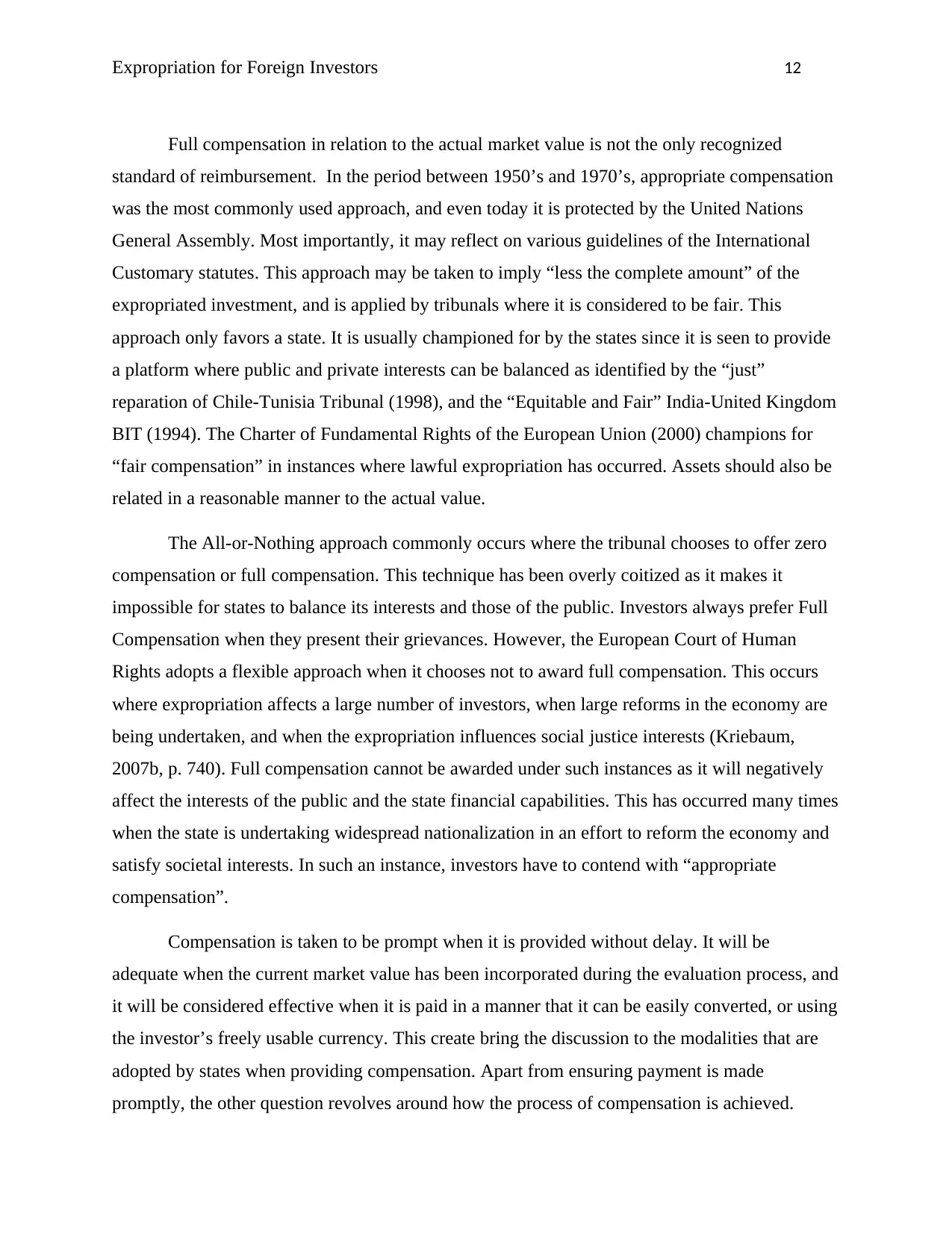
Expropriation for Foreign Investors 12
Full compensation in relation to the actual market value is not the only recognized
standard of reimbursement. In the period between 1950’s and 1970’s, appropriate compensation
was the most commonly used approach, and even today it is protected by the United Nations
General Assembly. Most importantly, it may reflect on various guidelines of the International
Customary statutes. This approach may be taken to imply “less the complete amount” of the
expropriated investment, and is applied by tribunals where it is considered to be fair. This
approach only favors a state. It is usually championed for by the states since it is seen to provide
a platform where public and private interests can be balanced as identified by the “just”
reparation of Chile-Tunisia Tribunal (1998), and the “Equitable and Fair” India-United Kingdom
BIT (1994). The Charter of Fundamental Rights of the European Union (2000) champions for
“fair compensation” in instances where lawful expropriation has occurred. Assets should also be
related in a reasonable manner to the actual value.
The All-or-Nothing approach commonly occurs where the tribunal chooses to offer zero
compensation or full compensation. This technique has been overly coitized as it makes it
impossible for states to balance its interests and those of the public. Investors always prefer Full
Compensation when they present their grievances. However, the European Court of Human
Rights adopts a flexible approach when it chooses not to award full compensation. This occurs
where expropriation affects a large number of investors, when large reforms in the economy are
being undertaken, and when the expropriation influences social justice interests (Kriebaum,
2007b, p. 740). Full compensation cannot be awarded under such instances as it will negatively
affect the interests of the public and the state financial capabilities. This has occurred many times
when the state is undertaking widespread nationalization in an effort to reform the economy and
satisfy societal interests. In such an instance, investors have to contend with “appropriate
compensation”.
Compensation is taken to be prompt when it is provided without delay. It will be
adequate when the current market value has been incorporated during the evaluation process, and
it will be considered effective when it is paid in a manner that it can be easily converted, or using
the investor’s freely usable currency. This create bring the discussion to the modalities that are
adopted by states when providing compensation. Apart from ensuring payment is made
promptly, the other question revolves around how the process of compensation is achieved.
Full compensation in relation to the actual market value is not the only recognized
standard of reimbursement. In the period between 1950’s and 1970’s, appropriate compensation
was the most commonly used approach, and even today it is protected by the United Nations
General Assembly. Most importantly, it may reflect on various guidelines of the International
Customary statutes. This approach may be taken to imply “less the complete amount” of the
expropriated investment, and is applied by tribunals where it is considered to be fair. This
approach only favors a state. It is usually championed for by the states since it is seen to provide
a platform where public and private interests can be balanced as identified by the “just”
reparation of Chile-Tunisia Tribunal (1998), and the “Equitable and Fair” India-United Kingdom
BIT (1994). The Charter of Fundamental Rights of the European Union (2000) champions for
“fair compensation” in instances where lawful expropriation has occurred. Assets should also be
related in a reasonable manner to the actual value.
The All-or-Nothing approach commonly occurs where the tribunal chooses to offer zero
compensation or full compensation. This technique has been overly coitized as it makes it
impossible for states to balance its interests and those of the public. Investors always prefer Full
Compensation when they present their grievances. However, the European Court of Human
Rights adopts a flexible approach when it chooses not to award full compensation. This occurs
where expropriation affects a large number of investors, when large reforms in the economy are
being undertaken, and when the expropriation influences social justice interests (Kriebaum,
2007b, p. 740). Full compensation cannot be awarded under such instances as it will negatively
affect the interests of the public and the state financial capabilities. This has occurred many times
when the state is undertaking widespread nationalization in an effort to reform the economy and
satisfy societal interests. In such an instance, investors have to contend with “appropriate
compensation”.
Compensation is taken to be prompt when it is provided without delay. It will be
adequate when the current market value has been incorporated during the evaluation process, and
it will be considered effective when it is paid in a manner that it can be easily converted, or using
the investor’s freely usable currency. This create bring the discussion to the modalities that are
adopted by states when providing compensation. Apart from ensuring payment is made
promptly, the other question revolves around how the process of compensation is achieved.
⊘ This is a preview!⊘
Do you want full access?
Subscribe today to unlock all pages.

Trusted by 1+ million students worldwide
1 out of 23
Related Documents
Your All-in-One AI-Powered Toolkit for Academic Success.
+13062052269
info@desklib.com
Available 24*7 on WhatsApp / Email
![[object Object]](/_next/static/media/star-bottom.7253800d.svg)
Unlock your academic potential
Copyright © 2020–2026 A2Z Services. All Rights Reserved. Developed and managed by ZUCOL.



